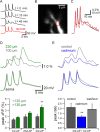Calcium spikes in basal dendrites of layer 5 pyramidal neurons during action potential bursts
- PMID: 16837590
- PMCID: PMC6674200
- DOI: 10.1523/JNEUROSCI.3062-05.2006
Calcium spikes in basal dendrites of layer 5 pyramidal neurons during action potential bursts
Abstract
Patch-clamp recording from dendrites has lead to a significant increase in our understanding of the mechanisms underlying signal integration and propagation in neurons. The majority of synaptic input to neurons, however, is made onto small-diameter dendrites, currently beyond the scope of patch-clamp recording techniques. Here we use both calcium and voltage imaging to investigate propagation of action potentials (APs) in fine basal dendrites of cortical layer 5 pyramidal neurons. High-frequency (200 Hz) AP bursts caused supralinear increases in dendritic calcium at distal, but not proximal, basal locations. Supralinear increases in dendritic calcium were also observed at distal basal locations during AP trains above a critical frequency (approximately 100 Hz). Using voltage imaging, we show that single APs undergo significant attenuation as they propagate into basal dendrites, whereas AP bursts lead to generation of dendritic calcium spikes. Focal and bath application of 4-AP increased the amplitude of calcium transients evoked by APs at distal, but not proximal, locations, suggesting that A-type potassium channels regulate AP backpropagation into basal dendrites. Finally, we show that pairing EPSPs with AP bursts is an effective means of activating synaptic NMDA receptors in basal dendrites. The experimental observations on the role of A-type potassium channels in regulation of AP backpropagation in basal dendrites, as well as the generation of dendritic calcium spikes during AP bursts, were reproduced in a morphologically realistic neuronal model with uniform distributions of dendritic sodium, calcium, and potassium channels. Together, these findings have important implications for understanding dendritic integration and synaptic plasticity in cortical basal dendrites.
Figures







References
Publication types
MeSH terms
Substances
LinkOut - more resources
Full Text Sources
Other Literature Sources
Molecular Biology Databases
Miscellaneous
